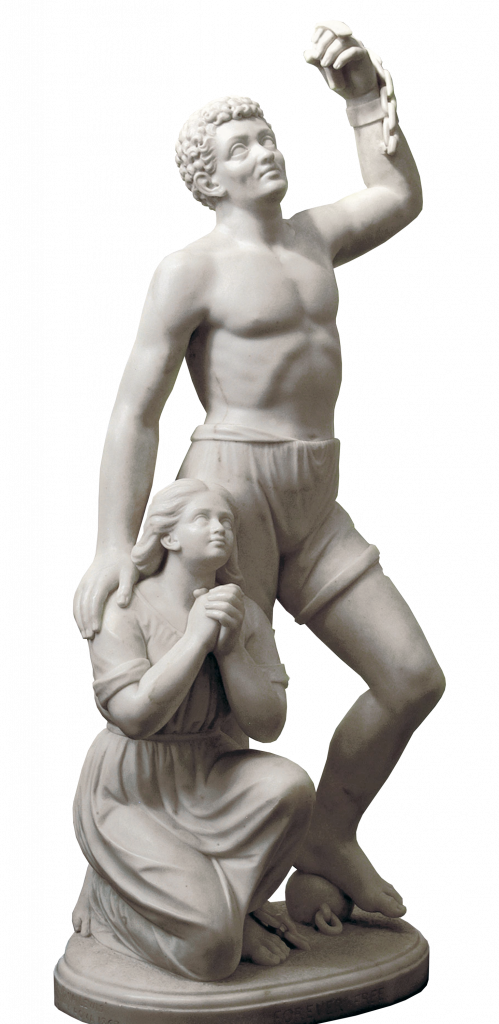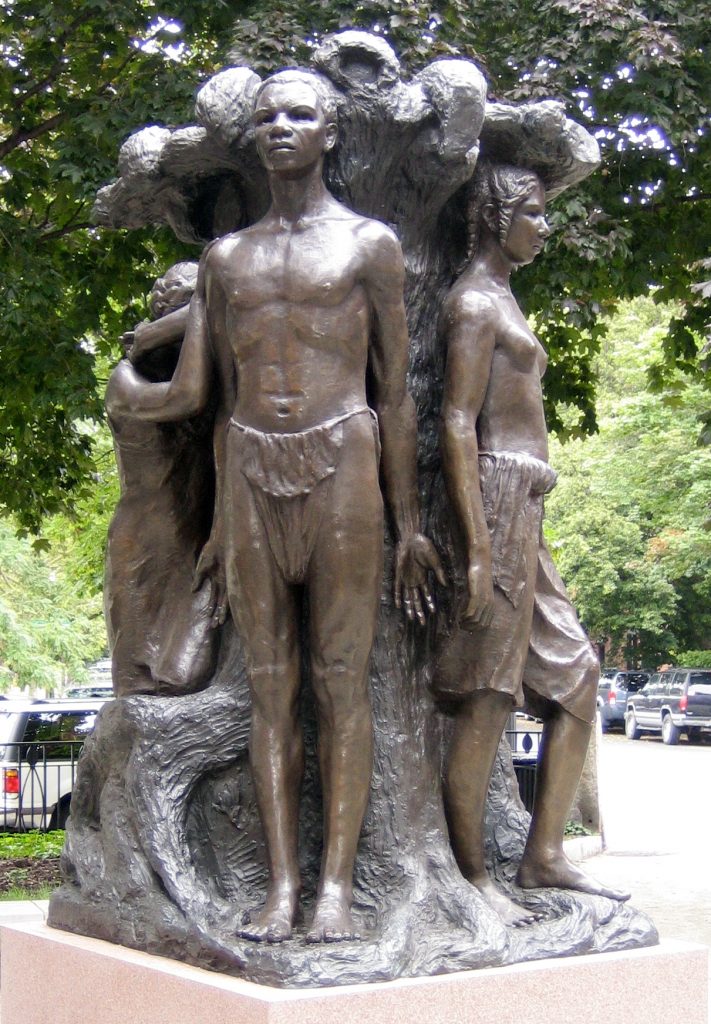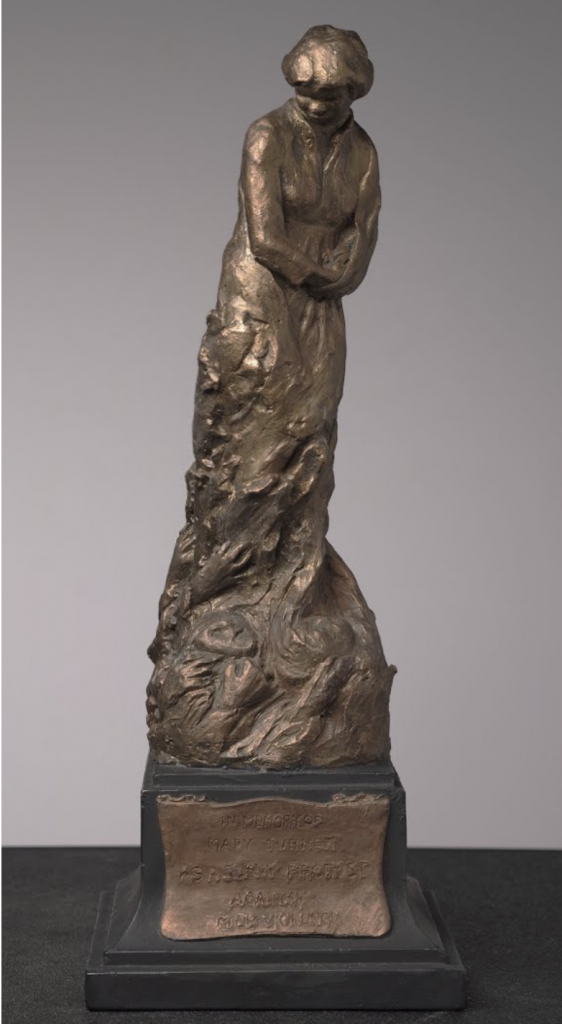The works by Meta Warrick Fuller that are best known today (and that is not saying much, because even those are not that well-known) are Emancipation (1913), Mary Turner: A Silent Protest Against Mob Violence (1919) and Ethiopia Awakening (1921). I have spent quite some time researching these, especially the first two, and I have much too much to say about them. But I do not want you, dear reader, to lose patience, or myself lose focus on the fact that this is a website dedicated to Edmonia Lewis. So I want to stick to my original goal and suggest some comparisons for each of these three to three of Lewis’ works that I see as related as anti-racist, pro-Black art. The overarching connection I see here is that both sculptors produce art that is, to use a paradoxical term, quietly protesting–its push for social, political and also art-historical change cloaked and veiled, only cautiously peeking through layers of restraint and caution in addressing questions of race and racism.
To be clear: I am not trying to making a case that Lewis directly influenced Fuller (although she clearly knew of her predecessor, and commented directly on Forever Free, as you can read below). Despite the similarities that I see between the two, it is important to stress the what divides them: Geographically, Fuller, unlike Lewis, returned to the US permanently after her European training and had much more of a connection to the African-American community of her time than Lewis who lived in Rome, then Paris, and eventually London, and does not seem to have traveled back to the US after the . Stylistically, Fuller, under the influence of Rodin, moved far beyond the neoclassicism that marks Lewis’ work from beginning to end (as far as we know, since we know so little about her work beyond the 1880s). And historically speaking, anti-racist activism (including through art) responds with different strategies to very different challenges that separate Lewis’ abolitionist art in the 1860s and 1870s from Fuller’s investment in Progressive “uplift suasion” and the work of the early NAACP against white violence, lynching, and the third resurgence of the Klan in the 1910s and 1920s. But by drawing connections between these works, I hope to show some of the through lines in terms of their activist art and also in terms of the limitations that both artists experienced in creating this kind of art as Black women–through lines that became clearer to me as I looked at, and thought about, these works in conjunction.
Forever Free (1867) and Emancipation (1913)


When it comes to Lewis’ Forever Free and Fuller’s Emancipation, the thematic link is obvious, even as material (marble vs. bronze) and size (41 1/2 inches/105 cm vs. 84 inches/213 cm) are quite different. Both explicitly celebrate the Emancipation Proclamation of 1863–Lewis immediately after the Civil War, and Fuller on the occasion of the 50th anniversary of the Emancipation Proclamation in 1913, celebrated with many expositions, parades, and other commemorative activities, especially in Black communities in the Northern states. Fuller’s work was, in fact, commissioned (by none other than W.E.B. Du Bois, whom Fuller knew personally) for the Emancipation Exposition in New York City, and prominently displayed, in painted plaster, in the “Temple of Beauty in the Great Court of Freedom” at the center of the exposition.*
It’s important to understand that both of these sculptures were unusual for their time in terms of how they depicted the newly emancipated–even as Fuller breaks with more conventions than Lewis. In the Forever Free post on this site, you can read in more detail about how Lewis’ decision to represent the Black freedman standing upright made her work stand apart from the usual depiction of the freed enslaved person kneeling in gratitude (for example, in Thomas Ball’s Emancipation Memorial from 1876). The man, shown with ethnically “African” features, standing erect, semi-nude, and with his arm raised in a gesture that is both triumphant and grateful, is clearly a predecessor of Fuller’s Black male figure. But (as I also discuss in more detail) Lewis’ female figure is kneeling, clothed, and seemingly under the protection of the freedman; she has the conventional “white” features of neoclassical females, and unlike the man, she is also still shackled.**
Fuller clearly understood the conventional gendering in Lewis’ work, although it is not clear that she objected–she told a friend that in Forever Free, “The man accepts [freedom] as a glorious victory, while the woman looks upon it as a precious gift.”*** But in her own Emancipation sculpture, she did not follow that precedent of emphasizing gender difference, and instead presented the male and female figures as equals, both standing tall against an enormous tree trunk, as if they were about to step away from it. Fuller herself described what the sculpture was supposed to represent: “Humanity weeping over her suddenly freed children, who, beneath the gnarled fingers of Fate, step forth into the world, unafraid”*** (Murray p. 56-57). The two young people are not looking at each other or in the same direction, since they stand at a right angle to each other, and, unlike Lewis’ pair, they are not touching. While they are about to leave behind the tree (which I interpret allegorically as slavery, firmly rooted in the society from which it sprang), they might not be going into the same direction if they follow their gaze–nothing indicates that they are bound together any more than they are bound to the tree. If anything, the female figures is a bit ahead of the male in “stepping forth into the world” because her right foot is forward, while his feet are both firmly planted as if still part of the root system that connects him to the tree).
In addition, Fuller also treats the two figures as equals in giving both ethnically Black figures (Fuller herself actually described these two figures as of a “mixed race” but did not specify further what she meant) and by representing them both as semi-nudes. Representing the woman with a bare upper torso and with Black features was doubly daring, even as this sculpture looks so tame to our 21st-century eyes: Combining female nudity and Blackness meant running the risk of triggering horrid racist and sexist stereotyping on, since Black women were so often represented as hypersexualized, animal-like, and seductive (something often referred to as the Jezebel stereotype). That in turn meant that it could also come under criticism from Black activists that wanted to make sure these stereotypes were not triggered, and who wanted their art to be non-controversial, if not conventional, to demonstrate, in the name of “Black uplift,” that Blacks were just as talented and capable as artists (and writers and musicians and scholars and politicians etc.) as the whites that held on to these racist stereotypes.
Fuller likely tried to steer against these risks by giving her figures their stern expressions and the near-hieratic stance (though not the body styles) of Egyptian, Babylonian or pre-classical Greek figures (like the archaic Greek kouroi and korai). And yet, the organizers of the Emancipation Exposition–or at least Du Bois himself, who had commissioned the piece–were apparently somewhat disappointed with the piece, as Fuller recalled later in personal correspondence and in interviews (you can read more about this in Ater’s book, where the sculpture and the commission are discussed in detail on pp.73-100). But even if they did think the semi-nude figures were scandalous or inappropriate, the sculpture was still prominently displayed at the Exposition (with an image later included in The Crisis).
Unlike Lewis, Fuller presents the two freed formerly enslaved people in a larger context–provided by both the tree, and the allegorical “Humanity,” the third figure, a woman standing sideways to the right of the young man, with her head turned away from us toward the tree, shielding her eyes with her lower arm. Humanity does not appear the emancipated man and woman’s liberator, or an agent in their liberation, but as an anxious bystander whose touch of the man’s shoulder might signale support or even a blessing as they move forward, but whose sorrow and averted face bespeak her worry for them and for the troubles lying ahead.
And if the tree behind around which the three figures are grouped represents the “fate” of slavery, as I would argue, it is a pivotal part of the allegorical representation of emancipation. Its massive, gnarled roots, on which the two figures are still standing, go deep and represent much more than the slavery of the past—they represent the far reaches o its legacy. As Fuller told Murray for his essay on her sculpture, the “The Negro has been emancipated from slavery, but not from the curse of race hatred and prejudice”*** from which Black people, in Fuller’s and many other Black activists’ view, had not been freed by 1913 (and from which “Humanity” seems to be unwilling to free itself, even as it hides its head in shame and fear). To Fuller, its branches were “the fingers of Fate grasping at them to draw them back into the fateful clutches of hatred.”*** The youth of the two figures implies that slavery is their point of origin, and emancipation their true beginning as fully acknowledged human beings. Even as they may not be younger than Lewis’ couple, they seem to have a lot of growing to do. Their stern, unsmiling faces convey not triumph, like Lewis’ male, or gratitude, like her female, but the courage and stoicism it takes to face what is coming (and in 1913, is already known to have come) after Emancipation, in terms of racist oppression and white supremacist backlash decade after decade, during and especially after Reconstruction.
Stylistically, this sculpture is very hard to categorize. As the representation of an idea, it partly still evokes 19th-century allegorical sculpture, and the physical features of the two figures are classically sculpted. In that respect, it has only deviated part way from Lewis’ Neoclassicism, but given the emotional weight of the ideas that are expressed here, it also owes much to the Symbolist and Expressionist sculptures of Rodin, who was an enormous influence on Fuller’s early figures and made their mark on the way she represents the tree. Not only does its rough bark show the hallmark traces of carving and shaping tools; the gnarls and fantastic twists and turns, the chopped of branches and the almost torso-like quality of the tree’s “backside” (where there is no figure) evoke Rodin. His imprint is also visible in the next sculpture I want to compare to a work of Lewis’, but in which Fuller withdraws from the idea of representing a Black female in the nude (as far as I know, she never again created a nude or semi-nude female sculpture for public display), but explores once more how she can address plight of Black people in America in her own time.
* The Exposition was held from October 22 to 31, 1913, at the Twelfth Regiment Armory on 62nd St., and the organizers reported in the Crisis (the NAACP’s widely-circulated magazine) that about 30,000 people attended, most of them Black. The sculpture was not cast in bronze until 1998, by the National Center of Afro-American Artists and the Museum of African American History, Boston and Nantucket, for display at Harriet Tubman Square in Boston.
** I have not been able to inspect the sculpture at Howard University to see this detail, but according to a video lecture Kirsten Buick gave at for the UK’s Public Statues and Sculpture Association (18 May 2021), the woman’s ankles are not only in shackles, but these are represented as still chained to the base of the sculpture, whereas the shackles on the man’s wrist are broken and the ball and chain under his foot no longer tethered. Whether this is a sly protofeminist dig at the lack of freedom of freedwomen with respect to their husbands is very hard to say.
*** The quotations in this segment are all from Freeman Henry Morris Murray’s Emancipation and the Freed in American Sculpture: A Study in Interpretation (Washington DC: Murray Brothers, 1916). Murray became a personal friend of Fuller’s, and one of his chapters in the book focuses exclusively on her Emancipation. For Fuller on Lewis, see p. 225. The passages about her own work are from pp.56-57, and two of them (“Humanity…” and “The Negro…”) are engraved on the pedestal of the bronze cast at Harriet Tubman Square.
Hagar and Mary Turner: A Silent Protest Against Mob Violence


~ In the Works! ~
Media alternatives:
(1) A video I made for a class about the 1913 Emancipation. Again, disclaimer: I am NOT a pro at videography, and this is just a Power Point lecture, with “ums” and stumbles.